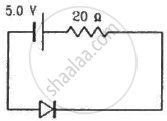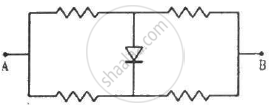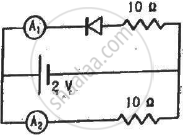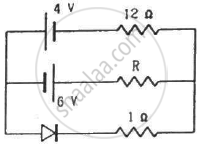Advertisements
Advertisements
प्रश्न
Consider a p-n junction diode having the characteristic \[i - i_0 ( e^{eV/kT} - 1) \text{ where } i_0 = 20\mu A\] . The diode is operated at T = 300 K . (a) Find the current through the diode when a voltage of 300 mV is applied across it in forward bias. (b) At what voltage does the current double?
उत्तर
(a) Given:-
Drift current, i0 = 20 × 10−6 A
Temperature, T = 300 K
Applied voltage, V = 300 mV
The variation in the current with respect to the voltage is given by
\[i = i_0 \left( e^\frac{eV}{KT} - 1 \right)\]
\[ \Rightarrow i = 20 \times {10}^{- 6} \left( e^\frac{0 . 3}{8 . 62 \times 300 \times {10}^{- 5}} - 1 \right)\]
\[ \Rightarrow i = 20 \times {10}^{- 5} \left( e^\frac{100}{8 . 61} - 1 \right)\]
\[ \Rightarrow i = 2 . 18 A \approx 2 \] A
(b) We need to find the voltage at which the current doubles so that the new value of the current becomes 4 A.
\[\Rightarrow 4 = 20 \times {10}^{- 6} \left( e^\frac{eV}{8 . 62 \times 3 \times {10}^{- 3}} - 1 \right)\]
\[ \Rightarrow e^\frac{V \times {10}^3}{8 . 62 \times 3} - 1 = \frac{4 \times {10}^6}{20}\]
\[ \Rightarrow e^\frac{V \times {10}^3}{8 . 62 \times 3} = 200001\]
\[ \Rightarrow \frac{V \times {10}^3}{8 . 62 \times 3} = 12 . 2060\]
\[ \Rightarrow V = \frac{12 . 206 \times 8 . 63 \times 3}{{10}^3}\]
\[ \Rightarrow V = 318 \] mV
APPEARS IN
संबंधित प्रश्न
In a p-n junction diode, the current I can be expressed as
I = `"I"_0 exp ("eV"/(2"k"_"BT") - 1)`
where I0 is called the reverse saturation current, V is the voltage across the diode and is positive for forward bias and negative for reverse bias, and I is the current through the diode, kBis the Boltzmann constant (8.6×10−5 eV/K) and T is the absolute temperature. If for a given diode I0 = 5 × 10−12 A and T = 300 K, then
(a) What will be the forward current at a forward voltage of 0.6 V?
(b) What will be the increase in the current if the voltage across the diode is increased to 0.7 V?
(c) What is the dynamic resistance?
(d) What will be the current if reverse bias voltage changes from 1 V to 2 V?
Write the two processes that take place in the formation of a p-n junction.
Explain briefly with the help of necessary diagrams, the reverse biasing of a p-n junction diode. Also draw characteristic curves.
Explain, with the help of a circuit diagram, the working of a photo-diode. Write briefly how it is used to detect the optical signals.
How is a zener diode fabricated so as to make it a special purpose diode? Draw I-V characteristics of zener diode and explain the significance of breakdown voltage.
Explain briefly, with the help of a circuit diagram, how a p-n junction diode works as a half wave rectifier.
When a p-type impurity is doped in a semiconductor, a large number of holes are created, This does not make the semiconductor charged. But when holes diffuse from the p-side to the n-side in a p-n junction, the n-side gets positively charged. Explain.
Diffusion current in a p-n junction is greater than the drift current in magnitude
In a p-n junction,
(a) new holes and conduction electrons are produced continuously throughout the material
(b) new holes and conduction electrons are produced continuously throughout the material except in the depletion region
(c) holes and conduction electrons recombine continuously throughout the material
(d) holes and conduction electrons recombine continuously throughout the material except in the depletion region.
A semiconducting device is connected in a series circuit with a battery and a resistance. A current is found to pass through the circuit. If the polarity of the battery is reversed, the current drops to almost zero. the device may be
(a) an intrinsic semiconductor
(b) a p-type semiconductor
(c) an n-type semiconductor
(d) a p-n junction
The drift current in a p-n junction is 20.0 µA. Estimate the number of electrons crossing a cross section per second in the depletion region.
Calculate the current through the circuit and the potential difference across the diode shown in figure. The drift current for the diode is 20 µA.

Each of the resistance shown in figure has a value of 20 Ω. Find the equivalent resistance between A and B. Does it depend on whether the point A or B is at higher potential?

What are the readings of the ammeters A1 and A2 shown in figure. Neglect the resistance of the meters.

(Assume that the resistance of each diode is zero in forward bias and is infinity in reverse bias.)
Find the current through the resistance R in figure if (a) R = 12Ω (b) R = 48Ω.

(Assume that the resistance of each diode is zero in forward bias and is infinity in reverse bias.)
A diode, a resistor and a 50 Hz AC source are connected in series. The number of current pulses per second through the resistor is __________ .
Answer in detail.
Discuss the effect of external voltage on the width of depletion region of a p-n junction.
In a semiconductor diode, the barrier potential offers opposition to only ______.
p-n junction diode is formed
Zener breakdown occurs in a p-n junction having p and n both:
